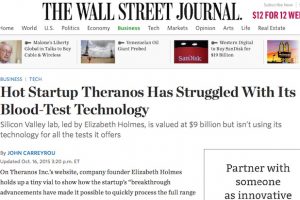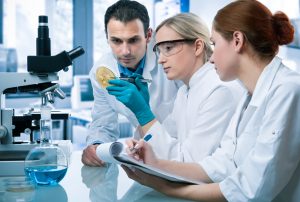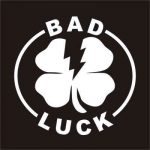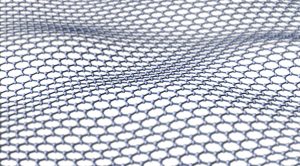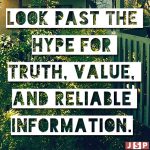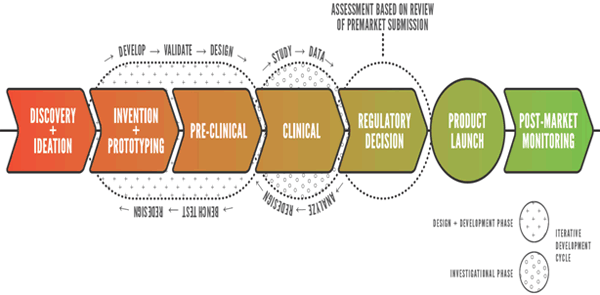Background: Theranos is a medical diagnostic company that promised consumers and medical practitioners affordable, painless, and less invasive blood tests to aid in the diagnosis of a variety of different medical conditions and illnesses with only drawing a drop of blood. The company was founded by Elizabeth Holmes, a first year Stanford dropout in 2003. The company had the ambition of replacing needles with the prick of a finger and threatens to uproot the global multi-billion dollar lab diagnostic industry. The company reached $9 billion USD valuation with half of the company owned by Holmes making her the youngest female self-made billionaire.
Accusation: In October of 2015, the WSJ accused the company of using traditional diagnostic machines to run the majority of its blood tests while only using its Edison diagnostic machine for fifteen of the blood tests. The FDA has only approved one of the tests run on Edison due to inaccurate diagnostic results from blood dilution and from the Edison machine. This revelation threatened the business model for Theranos as its main product does not work and should not have reached unicorn multi-billion dollar valuation. Information or testimonies provided by past employees showed that the company had repeatedly violated diagnostic lab standards and failed to fix these violations.
Result: In mid April of 2016, the US securities commission is looking into criminal charges against Theranos and investigating whether or not it had deceived investors. Federal health regulators are looking into issuing Elizabeth Holmes a two year minimum ban from being an officer within the diagnostic industry.
Early days: Elizabeth Holmes’ father Christian Holmes IV was Global Water Coordinator for USAID with deep rich connections within wealthy circles. Her early investors included Timothy Draper, a childhood neighbor, and Don Lucas who was a college friend of her father. While this has made early funding easier, Elizabeth Holmes still mastered the art of persuasion to convince investors to invest millions into her company.
Commentary:
Building a medical company that involves the FDA such as developing a new drug, creating a new medical device or even working on novel breakthrough research is very different than building a traditional business. When one works in a traditional business and does activities such as writing a report or working on constructing a building project, there is a sense of accomplishment daily because one can see progress and can roughly estimate when their project or report will be finished. If the company hired the right talent, there is a good chance that the project will turn out well and be deliverable favorably to the client or the consumer.
Contrasting the step by step completion projects we just discussed with developing a new drug, creating a new medical device, or doing novel research. These activities require the work of some of the top talent within their niche scientific fields. Every day, the scientists spend hours in the lab unsure if today will be the day of a major breakthrough they are looking for. Weeks or even months can go by with no signs of progress which can be disheartening as one is unable to see the fruits of their labor. The scientists hope and dream that tomorrow is the day that the breakthrough happens and they are able to see the progress of their labor.
Relating this back to Theranos, one might conclude that the company needed luck or a breakthrough which it was not lucky enough to get. When their valuation was driven into the billions, there was no other company with a successful product similar to the Edison machine that Theranos could acquire and use the acquired company’s proprietary technology to save itself. A material part of Thomas Edison’s wealth was derived from the efforts of Nicolas Tesla. Theranos could not attract the Nicolas Tesla equivalent for their Edison machine. Moreover, technology has not evolved quickly enough for Theranos to adopt current existing technology and build on current innovations.
Within the drone industry, the global development of video technology, GPS and other technological advances has allowed the rapid development of collision avoidance technology with a much lower cost and a lot less time compared to five years ago. Theranos had to create multiple breakthrough technologies in order for their Edison machine to work. For example, the creation of graphene sensors has allowed pollution levels to be measured in ppb (parts per billion). If an equivalent sensor was developed for blood tests, then Theranos would not have needed to dilute blood samples which further added to the inaccuracy of the blood tests and even impacting the accuracy of the older traditional diagnostic machines.
How Holmes likely raised funding:
When Elizabeth Holmes founded Theranos, it was built more similar to Silicon Valley technology companies than a medical company. When money was invested into Theranos, it was assumed that the scientists and engineers will eventually make the technology work. Thus, large funding rounds to commercialize the technology, and secure deals worth hundreds of millions with major retailers to open blood diagnostic centers within grocery stores including Safeway and Walgreens were signed. The mastery of public relations on various media outlets further added to the company’s hype. At the same time or later, the Edison machine was submitted for regulatory approval even though there was not enough credible data for regulatory approval. During the later stage investment rounds, one speculates that Theranos was vague in the use of the Edison machine in running diagnostic tests. Its progress in seeking regulatory approval with a just do it and seek regulatory approval later attitude similar to the operation of Uber in taxi licensed cities did not help its cause.
What Holmes should have done:
When one builds a company that can affect the life or death of a patient, strong regulatory approval cannot be avoided or negotiated later. When Holmes had built Theranos, she should have developed a technology that would have passed regulatory approval or acquired a company that had passed regulatory approval. Only then should Theranos have pursued commercialization. Unlike normal technology, one cannot release a minimum viable product into the market in the medical devices space and risk harming human lives.
The business concept and message behind her company was simple with a huge impact on health and huge profit potential and attracted many prominent investors because the main idea behind the company could be understood easily by non-scientists. However, the business aspect of the business such as the ability to seek funding, to attract business partners, to grow the list of potential clients and to gain patients has greatly outpaced the scientific advancement aspect of Theranos. The overpromise to these retail partners, investors, patients and clients compared to the challenges of developing a new blood diagnostic technology led to cover-ups which snowballed into bigger problems. The eventual discovery of this scandal by Wall Street Journal led to greater scrutiny of Theranos by regulators and the general public.
Takeaway: Theranos has shown that in order to build a successful company and change the world, one need to develop the scientific aspect of the business in addition to marketing and business technology. To build a medical company without sound science will soon lead to its inevitable collapse.
Currently, the career path for scientists is not considered lucrative with many underemployed or choosing different career paths including accounting. However, I believe that science will make a comeback especially with the need to innovate in the scientific field and act as the driving force behind many of the future technological innovations and advancement including blood diagnostics, and lithium batteries, We need to train more talented scientists who can overcome these challenges and develop new innovation to better the world while compensating them enough to attract the best into the field.

